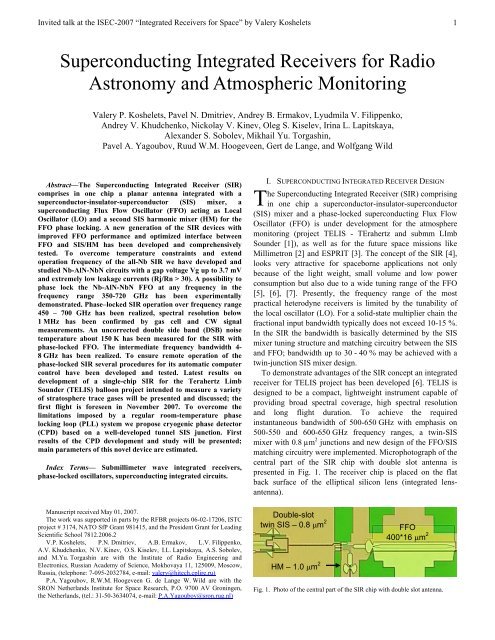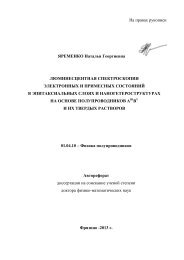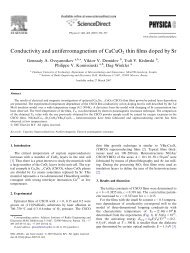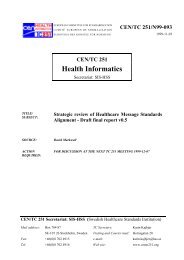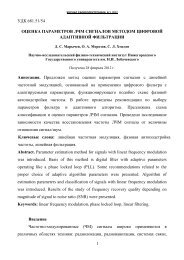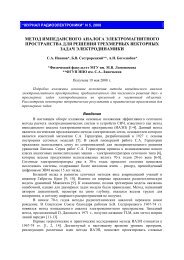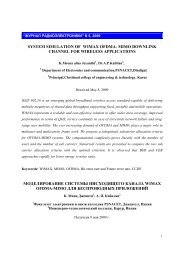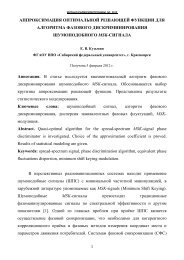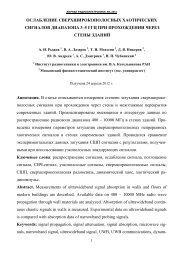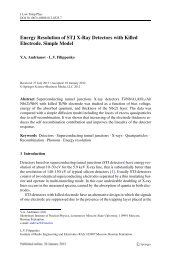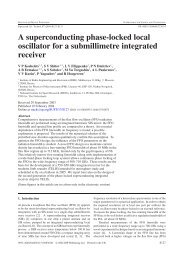SIR for Space - Institute of Radio-engineering and Electronics of RAS.
SIR for Space - Institute of Radio-engineering and Electronics of RAS.
SIR for Space - Institute of Radio-engineering and Electronics of RAS.
You also want an ePaper? Increase the reach of your titles
YUMPU automatically turns print PDFs into web optimized ePapers that Google loves.
Invited talk at the ISEC-2007 “Integrated Receivers <strong>for</strong> <strong>Space</strong>” by Valery Koshelets 1<br />
Superconducting Integrated Receivers <strong>for</strong> <strong>Radio</strong><br />
Astronomy <strong>and</strong> Atmospheric Monitoring<br />
Valery P. Koshelets, Pavel N. Dmitriev, Andrey B. Ermakov, Lyudmila V. Filippenko,<br />
Andrey V. Khudchenko, Nickolay V. Kinev, Oleg S. Kiselev, Irina L. Lapitskaya,<br />
Alex<strong>and</strong>er S. Sobolev, Mikhail Yu. Torgashin,<br />
Pavel A. Yagoubov, Ruud W.M. Hoogeveen, Gert de Lange, <strong>and</strong> Wolfgang Wild<br />
Abstract—The Superconducting Integrated Receiver (<strong>SIR</strong>)<br />
comprises in one chip a planar antenna integrated with a<br />
superconductor-insulator-superconductor (SIS) mixer, a<br />
superconducting Flux Flow Oscillator (FFO) acting as Local<br />
Oscillator (LO) <strong>and</strong> a second SIS harmonic mixer (HM) <strong>for</strong> the<br />
FFO phase locking. A new generation <strong>of</strong> the <strong>SIR</strong> devices with<br />
improved FFO per<strong>for</strong>mance <strong>and</strong> optimized interface between<br />
FFO <strong>and</strong> SIS/HM has been developed <strong>and</strong> comprehensively<br />
tested. To overcome temperature constraints <strong>and</strong> extend<br />
operation frequency <strong>of</strong> the all-Nb <strong>SIR</strong> we have developed <strong>and</strong><br />
studied Nb-AlN-NbN circuits with a gap voltage Vg up to 3.7 mV<br />
<strong>and</strong> extremely low leakage currents (Rj/Rn > 30). A possibility to<br />
phase lock the Nb-AlN-NbN FFO at any frequency in the<br />
frequency range 350-720 GHz has been experimentally<br />
demonstrated. Phase–locked <strong>SIR</strong> operation over frequency range<br />
450 – 700 GHz has been realized, spectral resolution below<br />
1 MHz has been confirmed by gas cell <strong>and</strong> CW signal<br />
measurements. An uncorrected double side b<strong>and</strong> (DSB) noise<br />
temperature about 150 K has been measured <strong>for</strong> the <strong>SIR</strong> with<br />
phase-locked FFO. The intermediate frequency b<strong>and</strong>width 4-<br />
8 GHz has been realized. To ensure remote operation <strong>of</strong> the<br />
phase-locked <strong>SIR</strong> several procedures <strong>for</strong> its automatic computer<br />
control have been developed <strong>and</strong> tested. Latest results on<br />
development <strong>of</strong> a single-chip <strong>SIR</strong> <strong>for</strong> the Terahertz Limb<br />
Sounder (TELIS) balloon project intended to measure a variety<br />
<strong>of</strong> stratosphere trace gases will be presented <strong>and</strong> discussed; the<br />
first flight is <strong>for</strong>eseen in November 2007. To overcome the<br />
limitations imposed by a regular room-temperature phase<br />
locking loop (PLL) system we propose cryogenic phase detector<br />
(CPD) based on a well-developed tunnel SIS junction. First<br />
results <strong>of</strong> the CPD development <strong>and</strong> study will be presented;<br />
main parameters <strong>of</strong> this novel device are estimated.<br />
Index Terms— Submillimeter wave integrated receivers,<br />
phase-locked oscillators, superconducting integrated circuits.<br />
T<br />
I. SUPERCONDUCTING INTEGRATED RECEIVER DESIGN<br />
he Superconducting Integrated Receiver (<strong>SIR</strong>) comprising<br />
in one chip a superconductor-insulator-superconductor<br />
(SIS) mixer <strong>and</strong> a phase-locked superconducting Flux Flow<br />
Oscillator (FFO) is under development <strong>for</strong> the atmosphere<br />
monitoring (project TELIS - TErahertz <strong>and</strong> submm LImb<br />
Sounder [1]), as well as <strong>for</strong> the future space missions like<br />
Millimetron [2] <strong>and</strong> ESPRIT [3]. The concept <strong>of</strong> the <strong>SIR</strong> [4],<br />
looks very attractive <strong>for</strong> spaceborne applications not only<br />
because <strong>of</strong> the light weight, small volume <strong>and</strong> low power<br />
consumption but also due to a wide tuning range <strong>of</strong> the FFO<br />
[5], [6], [7]. Presently, the frequency range <strong>of</strong> the most<br />
practical heterodyne receivers is limited by the tunability <strong>of</strong><br />
the local oscillator (LO). For a solid-state multiplier chain the<br />
fractional input b<strong>and</strong>width typically does not exceed 10-15 %.<br />
In the <strong>SIR</strong> the b<strong>and</strong>width is basically determined by the SIS<br />
mixer tuning structure <strong>and</strong> matching circuitry between the SIS<br />
<strong>and</strong> FFO; b<strong>and</strong>width up to 30 - 40 % may be achieved with a<br />
twin-junction SIS mixer design.<br />
To demonstrate advantages <strong>of</strong> the <strong>SIR</strong> concept an integrated<br />
receiver <strong>for</strong> TELIS project has been developed [6]. TELIS is<br />
designed to be a compact, lightweight instrument capable <strong>of</strong><br />
providing broad spectral coverage, high spectral resolution<br />
<strong>and</strong> long flight duration. To achieve the required<br />
instantaneous b<strong>and</strong>width <strong>of</strong> 500-650 GHz with emphasis on<br />
500-550 <strong>and</strong> 600-650 GHz frequency ranges, a twin-SIS<br />
mixer with 0.8 µm 2 junctions <strong>and</strong> new design <strong>of</strong> the FFO/SIS<br />
matching circuitry were implemented. Microphotograph <strong>of</strong> the<br />
central part <strong>of</strong> the <strong>SIR</strong> chip with double slot antenna is<br />
presented in Fig. 1. The receiver chip is placed on the flat<br />
back surface <strong>of</strong> the elliptical silicon lens (integrated lensantenna).<br />
Manuscript received May 01, 2007.<br />
The work was supported in parts by the RFBR projects 06-02-17206, ISTC<br />
project # 3174, NATO SfP Grant 981415, <strong>and</strong> the President Grant <strong>for</strong> Leading<br />
Scientific School 7812.2006.2<br />
V.P. Koshelets, P.N. Dmitriev, A.B. Ermakov, L.V. Filippenko,<br />
A.V. Khudchenko, N.V. Kinev, O.S. Kiselev, I.L. Lapitskaya, A.S. Sobolev,<br />
<strong>and</strong> M.Yu. Torgashin are with the <strong>Institute</strong> <strong>of</strong> <strong>Radio</strong> Engineering <strong>and</strong><br />
<strong>Electronics</strong>, Russian Academy <strong>of</strong> Science, Mokhovaya 11, 125009, Moscow,<br />
Russia, (telephone: 7-095-2032784, e-mail: valery@hitech.cplire.ru)<br />
P.A. Yagoubov, R.W.M. Hoogeveen G. de Lange W. Wild are with the<br />
SRON Netherl<strong>and</strong>s <strong>Institute</strong> <strong>for</strong> <strong>Space</strong> Research, P.O. 9700 AV Groningen,<br />
the Netherl<strong>and</strong>s, (tel.: 31-50-3634074, e-mail: P.A.Yagoubov@sron.rug.nl)<br />
Double-slot<br />
twin SIS – 0.8 µm 2<br />
HM – 1.0 µm 2<br />
FFO<br />
400*16 µm 2<br />
Fig. 1. Photo <strong>of</strong> the central part <strong>of</strong> the <strong>SIR</strong> chip with double slot antenna.
Invited talk at the ISEC-2007 “Integrated Receivers <strong>for</strong> <strong>Space</strong>” by Valery Koshelets 2<br />
II. NB-ALN-NBN TUNNEL JUNCTIONS<br />
The implementation <strong>of</strong> an AlN tunnel barrier in<br />
combination with a NbN top superconducting electrode<br />
provides a significant improvement in SIS junction quality [7]<br />
compared to traditional Nb-AlN-Nb circuits. The gap voltage<br />
<strong>of</strong> the junction Vg = 3.7 mV that potentially allows operation<br />
<strong>of</strong> the SIS mixer up to 1.5 THz. In Fig. 2 typical currentvoltage<br />
dependencies <strong>of</strong> a Nb-AlN-NbN SIS mixer, pumped<br />
by a Nb-AlN-NbN FFO. One can see that the FFO provides<br />
more than enough power <strong>for</strong> mixer pumping. Although the<br />
Nb-AlN-NbN FFOs behave very similar to all-Nb ones there<br />
is a number <strong>of</strong> very important features related to energy gap<br />
structure <strong>and</strong> losses in the FFO (Josephson transmission line)<br />
due to NbN top electrode that differ their properties from<br />
regular all-Nb FFOs. It was demonstrated [7] that Nb-AlN-<br />
NbN FFOs provide continuous frequency tuning from 300 to<br />
700 GHz with linewidth well below 10 MHz that make<br />
possible the FFO phase-locking in very wide frequency range.<br />
SIS Current (mkA)<br />
300<br />
250<br />
200<br />
150<br />
100<br />
50<br />
HD13-09#26 (Vg=3.7mV, Rn=21 Ohm)<br />
Nb-AlN-NbN<br />
FFO Frequency:<br />
0 GHz<br />
400 GHz<br />
500 GHz<br />
600 GHz<br />
700 GHz<br />
0<br />
0 1 2 3 4 5 6 7<br />
SIS Voltage (mV)<br />
Fig. 2. The IVC <strong>of</strong> an SIS mixer pumped by an integrated FFO. Solid curve –<br />
unpumped mixer, dashed <strong>and</strong> dotted lines - pumped at different frequencies..<br />
III. <strong>SIR</strong> PERFORMANCE<br />
The <strong>SIR</strong> microcircuits have been tested as a receiver<br />
showing a possibility to realize the PL <strong>SIR</strong> concept. <strong>SIR</strong> chip<br />
is mounted in a flight configuration mixer block surrounded<br />
by a magnetic shield in a liquid helium cooled cryostat. Noise<br />
temperature measurements are done using Y-factor technique<br />
by chopping between hot (295 K) <strong>and</strong> cold (80 K) loads in the<br />
signal path <strong>of</strong> the receiver (see Fig. 3). IF response <strong>of</strong> the<br />
mixer is amplified by a cryogenic InP based 4-8 GHz lownoise<br />
amplifier (LNA) amplifier followed by a 60 dB gain<br />
GaAs room temperature amplifier. The signal is detected by a<br />
fast power meter. We have also used the flight configuration<br />
<strong>of</strong> the PLL system <strong>and</strong> could phase-lock the FFO practically at<br />
any frequency in the 450-650 GHz range.<br />
A new approach to tune out the mixer’s parasitic <strong>and</strong> filter’s<br />
capacitances suggested by Jacob Kooi was implemented in a<br />
recently developed <strong>and</strong> tested IF-network <strong>for</strong> the <strong>SIR</strong> [8]. A<br />
section <strong>of</strong> the coplanar line was grounded at RF by the<br />
integrated on-chip capacitors <strong>and</strong> worked as a shunt tuning<br />
inductance. As a result variation <strong>of</strong> the receiver noise<br />
temperature <strong>of</strong> about 50K was realized over IF b<strong>and</strong> 4–8 GHz.<br />
Receiver Noise Temperature (K)<br />
1000<br />
500<br />
0<br />
450 500 550 600 650 700<br />
FFO Frequency (GHz)<br />
Fig. 3. Uncorrected DSB noise temperature <strong>of</strong> the <strong>SIR</strong> as a function <strong>of</strong> the<br />
FFO frequency measured over IF b<strong>and</strong> = 4 - 8 GHz. A dip at 560 GHz is<br />
partially due to water vapor absorption line<br />
Far-field amplitude beam pattern <strong>of</strong> the integrated antenna<br />
measured at 625 GHz in a heterodyne mode with phaselocked<br />
FFO is symmetric with the first sidelobe level below -<br />
17 dB. It is close to the theoretically predicted diffraction<br />
pattern calculations; the full width half maximum (FWHM) is<br />
3 deg. To prove capability <strong>of</strong> the <strong>SIR</strong> <strong>for</strong> high-resolution<br />
spectroscopy we have successfully measured line pr<strong>of</strong>iles <strong>of</strong><br />
OCS gas around 625 GHz. As a back-end spectrometer we<br />
used Digital Auto Correlator (DAC). <strong>SIR</strong> was operated in a<br />
phase-locked mode. The spectrum recorded by the DAC is a<br />
convolution product <strong>of</strong> the signal (gas emission lines) with the<br />
FFO line spectrum, resolution is limited by DAC back-end. To<br />
recover the signal, we apply a simple direct deconvolution<br />
process using the measured FFO line shape.<br />
New superconducting element, a cryogenic phase detector<br />
(CPD) has been proposed <strong>and</strong> preliminary tested. The CPD is<br />
based on a SIS junction <strong>and</strong> intended <strong>for</strong> phase locking <strong>of</strong> a<br />
FFO in a <strong>SIR</strong>. First results <strong>of</strong> the CPD development <strong>and</strong> study<br />
are very encouraging [8]; a sinusoidal response <strong>of</strong> the CPD<br />
has been measured; phase locking <strong>of</strong> an FFO by the CPD with<br />
the spectral ratio as high as 80 % has been demonstrated.<br />
REFERENCES<br />
[1] R.W.M. Hoogeveen, et al., “New cryogenic heterodyne techniques<br />
applied in TELIS: the balloon borne THz <strong>and</strong> submm limb sounder <strong>for</strong><br />
atmospheric research”, Proc. <strong>of</strong> SPIE, Infrared <strong>Space</strong>borne Remote<br />
Sensing XI, 5152, p. 347-355, 2004.<br />
[2] http://www.asc.rssi.ru/millimetron/eng/millim_eng.htm<br />
[3] W. Wild, et al, “Terahertz Technology <strong>for</strong> ESPRIT – Far-Infrared <strong>Space</strong><br />
Interferometer”, The 16th International Symposium on <strong>Space</strong> Terahertz<br />
Technology, Sweden, May 2005, Proceedings ISSTT 2005, p. 68 - 73.<br />
[4] V. P. Koshelets <strong>and</strong> S. V. Shitov, “Integrated Superconducting<br />
Receivers,” Superconductor Science <strong>and</strong> Technology, vol. 13, pp. R53-<br />
R69, 2000.<br />
[5] T. Nagatsuma, K. Enpuku, F. Irie, <strong>and</strong> K. Yoshida, “Flux-flow type<br />
Josephson oscillator <strong>for</strong> mm <strong>and</strong> submm wave region,” J. Appl. Phys., vol.<br />
54, p. 3302, 1983, see also Pt. II: J. Appl. Phys. vol. 56, p. 3284, 1984; Pt. III,<br />
J. Appl. Phys., vol. 58, p. 441, 1985; Pt. IV, J. Appl. Phys., vol. 63, p. 1130,<br />
1988.<br />
[6] V.P. Koshelets, et al., “Superconducting Integrated Submillimeter<br />
Receiver <strong>for</strong> TELIS”, IEEE Trans. on Appl. Supercond., vol. 17, June<br />
2007.<br />
[7] M.Yu. Torgashin, et al., “Superconducting Integrated Receiver based on<br />
Nb-AlN-NbN-Nb Circuits”, IEEE Trans. on Appl. Supercond., vol. 17,<br />
June 2007.<br />
[8] A.V. Khudchenko, et al., “Cryogenic Phase Detector <strong>for</strong><br />
Superconducting Integrated Receiver”, IEEE Trans. on Appl.<br />
Supercond., vol. 17, June 2007.


